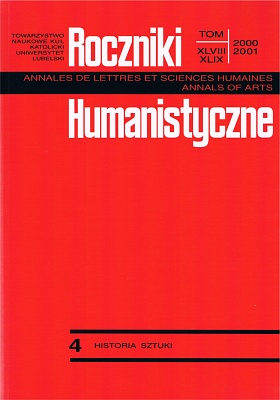The Architecture of the Building of the Catholic University of Lublin. History and Stylistic Inspirations
Abstract
The article is a summary of the Master's thesis entitled „The Catholic University of Lublin. An architectonic-historical monograph of the building complex”, written under the supervision of Dr Lechosław Lameński (in 2000) in the Institute of History of Art of the CUL and is concerned with the historical part of the building complex of the Catholic University of Lublin that has not been yet scientifically described. It consists of: the Holy Cross Academic Church, the former Dominican monastery, today rebuilt to a large extent, and the wings closing the main courtyard, built as army barracks.
The original wooden Holy Cross Church was built outside the town, near the road leading from Lublin to Cracow. It was a small, one-nave building with an ave-bell and arcades around the nave. The building can be seen in Hogenberg's engraving showing a panorama of the town of Lublin.
The brick church was built after 1618 in the renesans lubelski (Lublin Renaissance) style.
The year 1697 proved crucial for the church's history. It was then that the Dominican friars settled near it. A quadrangle monastery with an inner courtyard was built next to the church on the north side. The Dominicans had a considerable allowance and a good economic base.
In 1800 the monastery was dissolved and the Austrian army took over the monastery buildings with the intention of turning them into a hospital. The Dominican buildings were soon extended. In the period between 1800 and 1809 three wings were built that surrounded the inner courtyard. The inner elevations were given three storeys of open arcades. The architectonic forms used here clearly show a similarity to the theory formulated by the Professor of the Paris L'Ecole Polytechnique - Jean-Nicolas-Louis Durand. He created an architectonic doctrine that was based on utility and economy of the building.
A building with such a big capacity was probably designed to be a hospital, barracks, it could house army headquarters, or perhaps civilian authorities.
During the whole of the 19th century the buildings were used by the army. At the turn of the 1820s Russians built the wing closing the courtyard on the northern side and soon they walled up the arcades. From the 1860s probably until World War I the Riazan Infantry Regiment was stationed there.
After Poland regained independence the Świętokrzyskie Barracks (the name came from the invocation of the church) were given to the Catholic University of Lublin. Its authorities renovated the buildings according to the design by the architect Marian Lalewicz who restored their forms of monumental classicism, and in the case of the church he also used baroque motifs. In the 1970s the attic was adapted for rooms and a new front wing was built according to a design by S. Juchnowicz and K. Juchnowicz.
Copyright (c) 2001 Roczniki Humanistyczne

This work is licensed under a Creative Commons Attribution-NonCommercial-NoDerivatives 4.0 International License.





